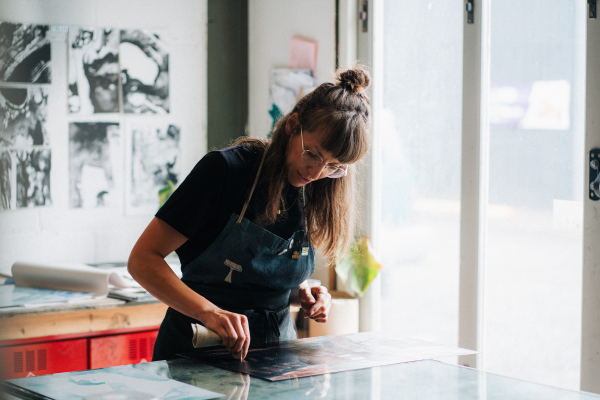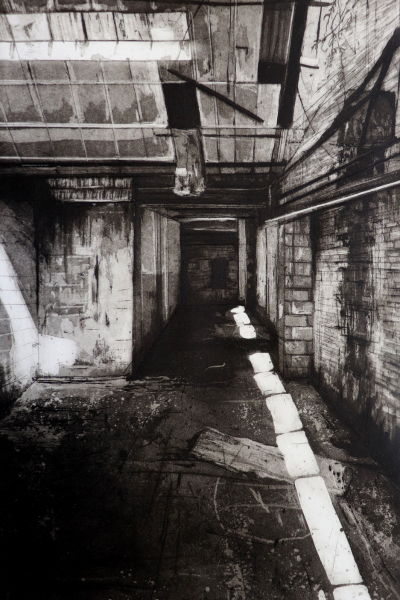
Jemma Gunning
Working closely with St Cuthberts Mill and focusing primarily on visual interpretations of decay within post-industrial landscapes, printmaker Jemma Gunning uses drawing as the foundation of every piece of art she creates. She talks exclusively to Painters Online about her artistic journey...
Getting in to art
What first sparked your passion for art?
My passion for art was ignited in my early years, nurtured by the encouragement of my parents. Birthdays and Christmases were marked by requests for art supplies and I spent countless hours sketching and drawing. This early exposure and support created a deep-seated love for creativity, setting the foundation for a lifelong journey in the world of art.
What were the key learnings you took from your BA in drawing? Are there any specific skills or tips that are still very much with you today?
My BA in drawing was a transformative journey that equipped me with foundational insights and enduring skills. One key learning was the paramount importance of observation. The discipline instilled in me the practice of keenly observing my surroundings, a skill that continues to shape my artistic perspective today.
Additionally, the emphasis on experimentation during my undergraduate studies has stayed with me. The freedom to explore diverse techniques and mediums not only broadened my creative horizons but also fostered a mindset of continuous learning. This willingness to experiment remains a cornerstone of my approach, allowing me to evolve as an artist.
The collaborative nature of certain projects during my BA exposed me to diverse artistic influences and working styles. This experience taught me the value of open communication, skills that prove invaluable in navigating the dynamic landscape of the art world.
In essence, my BA in drawing not only honed my technical skills but also instilled in me a spirit of curiosity, adaptability, and collaboration. They key learnings continue to guide and enrich my artistic practice today.

Robinsons Mill
Getting into printmaking and finding an interest in post-industrial landscapes
What made you decide to divert into printmaking for your MA? And how important were your drawing skills for progressing in this media?
Opting for printmaking in my MA was a deliberate choice to explore new artistic dimensions. Drawing has been crucial in this shift. The skills learnt in sketching provided a strong foundation, guiding my understanding of composition and form. As I transitioned to printmaking, drawing became the backbone, aiding in conceptualising and executing ideas.
Printmaking demands a keen eye for line and shading nuances, skills nurtured through years of drawing. The adaptability of my drawing proficiency has been instrumental in pushing the boundaries of traditional printmaking, infusing my creations with a distinctive touch.
For me, choosing printmaking for my MA was about innovation, and my drawing skills have proven indispensable in excelling in this dynamic artistic medium.

Jemma at work in her studio
How did your interest in abandoned spaces and the ingress of nature start?
My interest in abandoned spaces and the encroachment of nature began through the lens of psychogeography, a term that encapsulates the act of aimlessly wandering in a new place to seek inspiration. This unconventional approach to exploration became a personal ritual, especially when I found myself in unfamiliar territories. It was during such wanderings in Bristol that I stumbled upon abandoned buildings, with the new gaol on the harbour being the first to capture my attention.
This encounter sparked a profound curiosity in the stories of our fading heritage, and I set myself a mission - to document the beauty found in abandonment, decay, and the vestiges of our history. Exploring these neglected spaces became more than a visual endeavour; it evolved into a way to preserve the narratives embedded in forgotten architecture.

Permanite Ashpalt Works III
The allure of abandoned spaces lies in their ability to tell tales of the past, serving as silent witnesses to the passage of time. Nature, slowly reclaiming these structures, adds another layer to the narrative, creating a captivating interplay between man-made creations and the relentless force of the natural world.
My artistic exploration is driven by a commitment to capturing the essence of these forgotten places, during attention to the fragility of our architectural heritage and the poignant beauty that arises from the intersection of neglect and nature's resilience. This ongoing project stands as a testament to the significance of preserving the stories that echo within the decaying walls of our past.

A visual ode to the town's dominant limestone quarry
My 3x4m drawing, a focal point of my solo show at The Maltings during the 2023 Wirksworth Festival, is a visual ode to the town's dominant limestone quarry. Created during a three-month residency in 2022, the piece captures the essence of Wirkworth's post-industrial landscapes. The ochre pigment, meticulously sourced from a local cave, infuses the drawing with a site-specific significance, mirroring the warm tones of the limestone quarry. This deliberate choice not only honours the geological richness of the area but also highlights the delicate interplay between human industry and the natural world. Presented at the festival, the drawing invites viewers to reflect on the quarry's expansive presence and its impact on the community, fostering a visual dialogue that resonates with the evolving landscapes that define Wirksworth's history and future.
Don't miss out on future interviews - sign up to our e-newsletters to be the first to know when they are released!
The importance of traditional art skills and the growing world of AI
On your website you talk about etchings and other traditional hand skills as being a dying art, particularly in the digital world we now inhabit. How important is it to you that these skills are protected and encouraged? And how important is it that traditional artists utilise the digital world to survive?
Preserving traditional hand skills, such as etching, is vital in our digital age, offering us a connection to cultural heritage. These time-honoured techniques embody the essence of craftmanship and artistic authenticity. Encouraging and passing down these skills is a responsibility that ensures the continuation of a rich artistic legacy for future generations.
However, in the contemporary landscape, the integration of digital tools becomes a pragmatic necessity for traditional artists. While traditional techniques hold intrinsic value, adapting to the digital world widens the scope for creativity and engagement. The digital realm facilitates global reach, collaboration, and innovation exploration, allowing artists to navigate the evolving dynamics of the art industry.
In this symbiotic relationship between traditional and digital practices, the challenge is to strike a harmonious balance. It's not a matter of replacing one with the other but finding a nuanced integration that preserves the authenticity of hand skills while leveraging the digital era's potential for artistic survival and evolution. This dynamic coexistence ensures that traditional artistry remains vibrant and relevant in the ever-changing landscape of the arts.

Etching
DISCOVER MORE ABOUT ETCHING HERE
With the rapid progression of AI, are there concerns for the protection of the individuality of your work? Do you see AI as having a part in your own future where drawing and printing are concerned?
The rapid development of AI does raise concerns about protecting the individuality of artistic work. The essence of art often lies in the unique perspective, emotion, and personal touch that an artist brings to their creations. While AI can generate impressive outputs, the distinct human touch and nuanced creativity may be at risk.
In terms of my own future in drawing and printing, the integration of AI is an intriguing prospect. AI technologies can serve as valuable tools for artists, aiding in tasks like pattern recognition, procedural generation, or even suggesting creative elements. This collaboration between human intuition and machine assistance might open new avenues for exploration in my artistic practice.
However, its crucial to maintain a delicate balance, ensuring that AI complements rather than overrides the artist's vision. Preserving the human connection to the artistic process is vital for maintaining the authenticity and individuality that define each piece of work. The role of AI in my creative future will likely be one of collaboration and augmentation, where technology enhances, but does not replace, the core elements of artistic expression.
Finding the right paper for printmaking
Is the choice of paper key for printmaking? What features make St Cuthberts Mill papers a great fit for your work?
The paper choice in printmaking is crucial, and St Cuthberts Mill's Somerset Satin, especially the 300gsm version, is my preferred. This paper's reliability is key, offering a consistent texture and weight essential for predictable outcomes. it excels in enhancing etchings, allowing for faithful reproduction of details. The 300gsm weight adds a substantial feel to prints, combined with the satin finish, creating a high-quality aesthetic. St Cuthberts Somerset Satin has become my go-to for its reliability, ability to showcase etching nuances, and tactile quality.
Where you talk about the paper you use for printing, is there also a preferred choice via St Cuthberts for preliminary sketches etc?
I use Somerset for all my printing and drawing... it's so lovely to work with! Last year I created a 3x4m drawing using their giant Somerset roll which was a dream to work with.
For more about printmaker Jemma's work visit her website.
Looking to purchase products from St Cuthberts Mill? Art Supplies with Painters Online stocks a range of paper packs.
Enjoyed this interview? Sign up to our e-newsletter to be first to know when future articles are released!












Comments
Login or register to add a comment